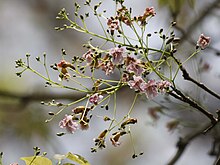Stereospermum chelonoides
| Stereospermum chelonoides | |
|---|---|

| |
| Stereospermum chelonoidesn tree in Bangladesh | |
| Scientific classification | |
| Kingdom: | Plantae |
| Clade: | Tracheophytes |
| Clade: | Angiosperms |
| Clade: | Eudicots |
| Clade: | Asterids |
| Order: | Lamiales |
| Family: | Bignoniaceae |
| Genus: | Stereospermum |
| Species: | S. chelonoides
|
| Binomial name | |
| Stereospermum chelonoides | |
| Synonyms[1] | |
| |
Stereospermum chelonoides is a deciduous tree native to South Asia.[2]

Flower in Bangladesh
In Theravada Buddhism, this plant is said to have used as the tree for achieved enlightenment, or Bodhi by third Buddha called "Saranankara - සරණංකර", and twenty second Buddha "Vipassi - විපස්සි". The plant is known as පුලිල (pulila) in Sanskrit, పాదిరి (pādiri) in Telugu, පලොල් (palol) in Sinhala and পারুল (parul) in Bengali.
References[]
- ^ The Plant List: A Working List of All Plant Species, retrieved 16 November 2016
- ^ Troup, Robert Scott (1921), The silviculture of Indian trees, Clarendon Press, pp. 688–689
External links[]
Categories:
- Stereospermum
- Trees of Nepal
- Bignoniaceae stubs